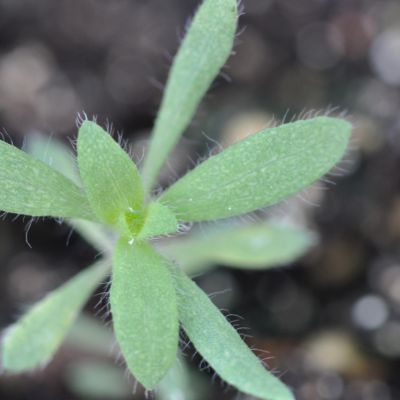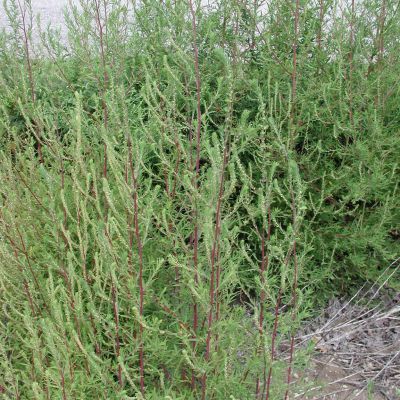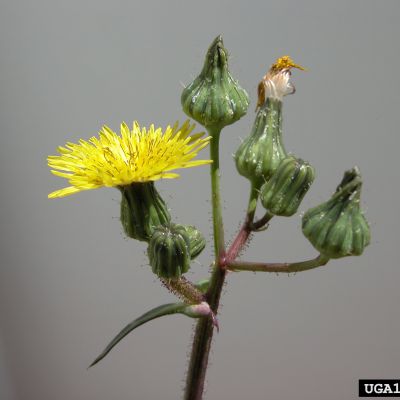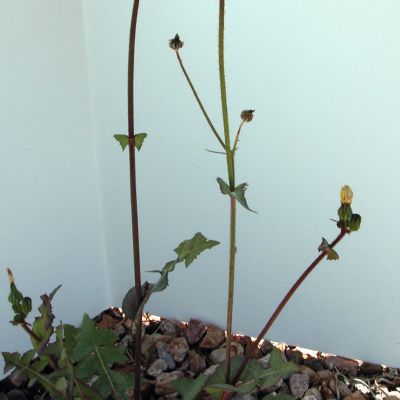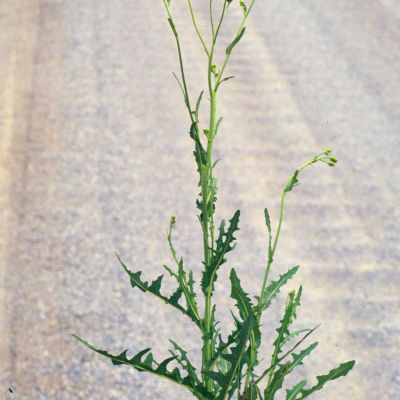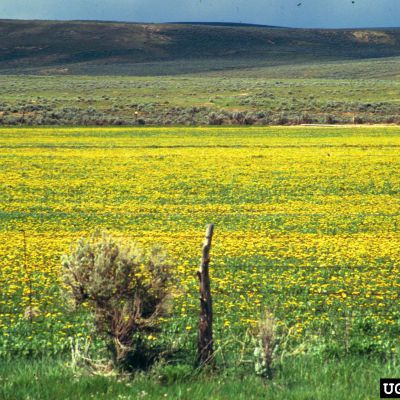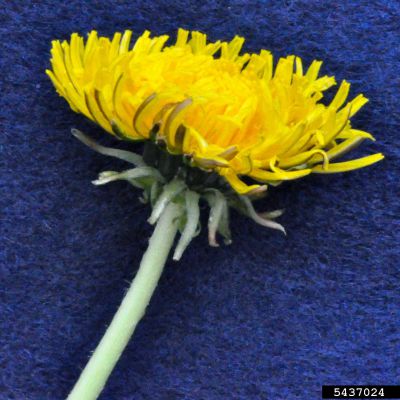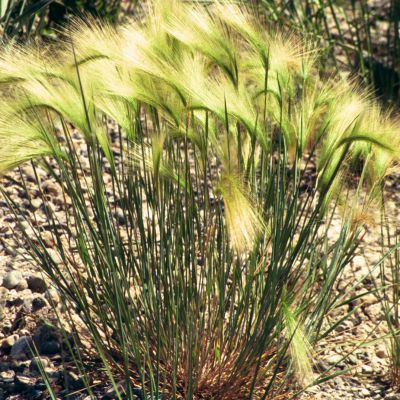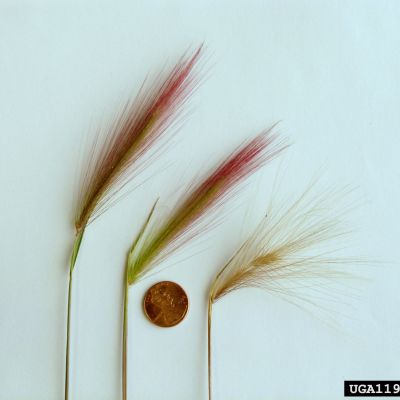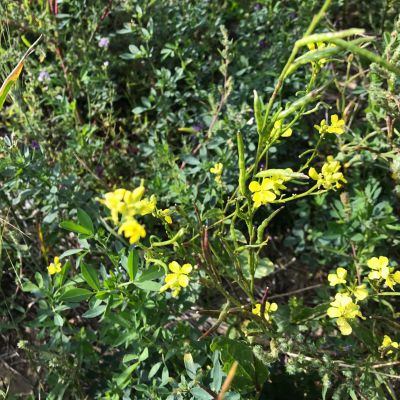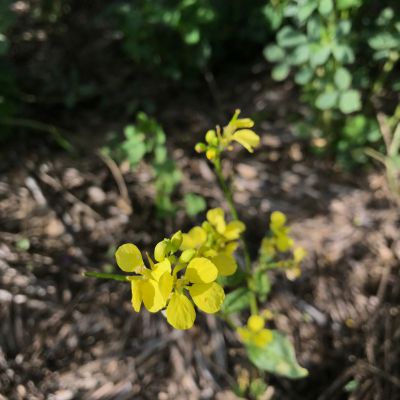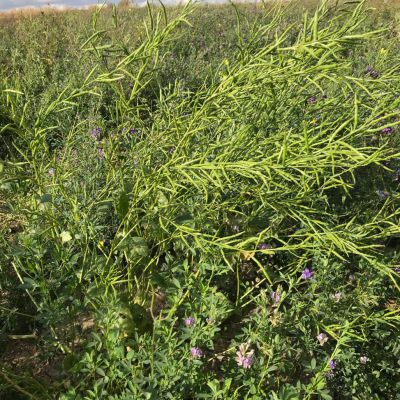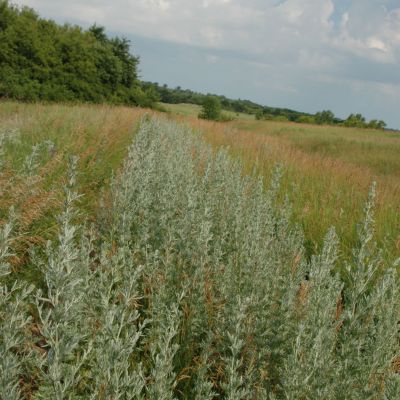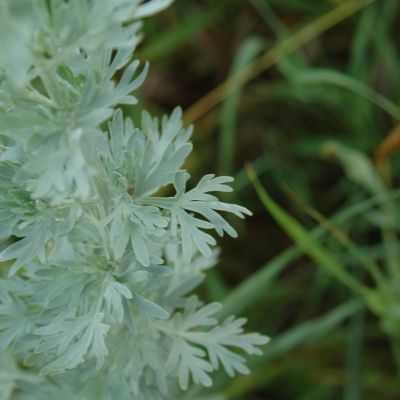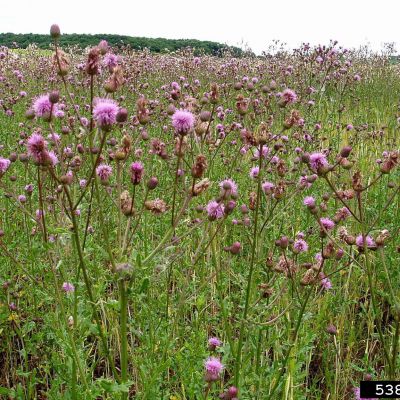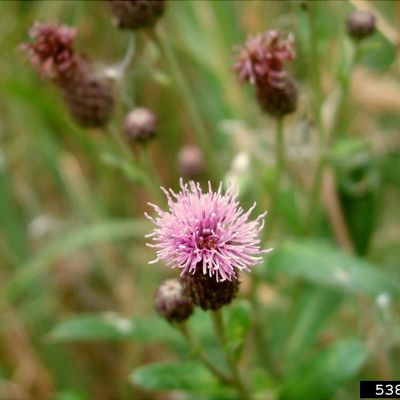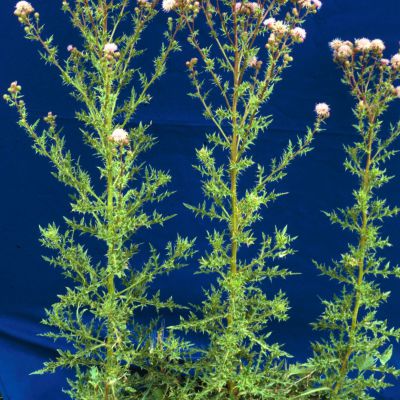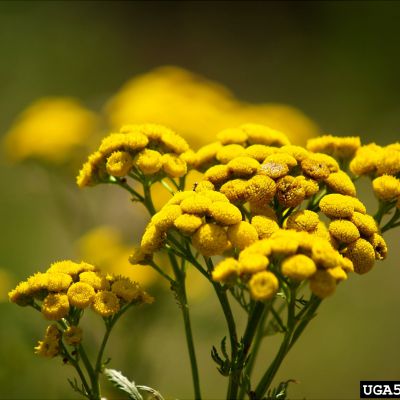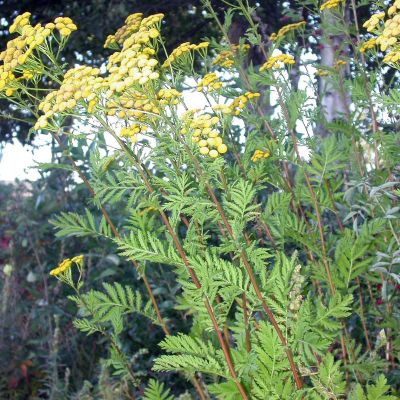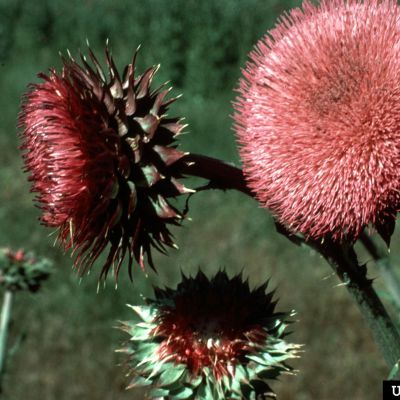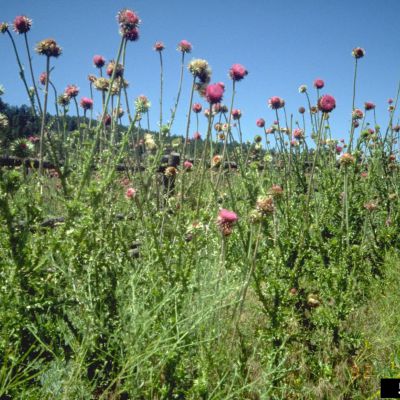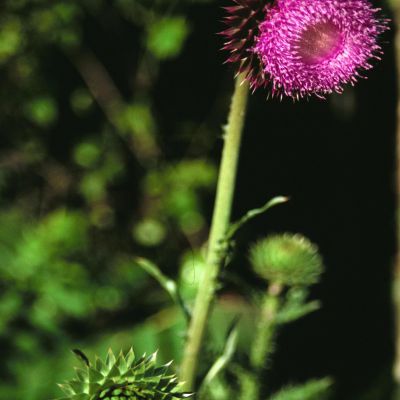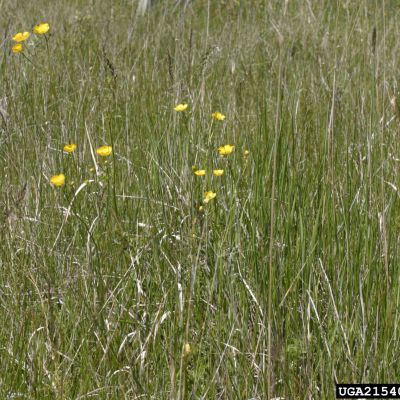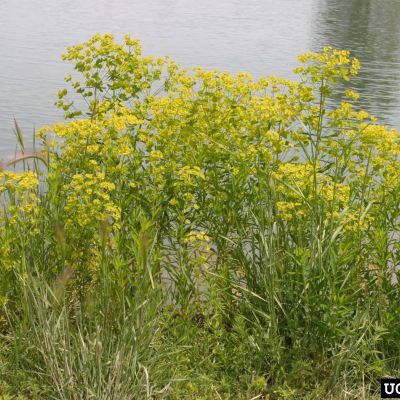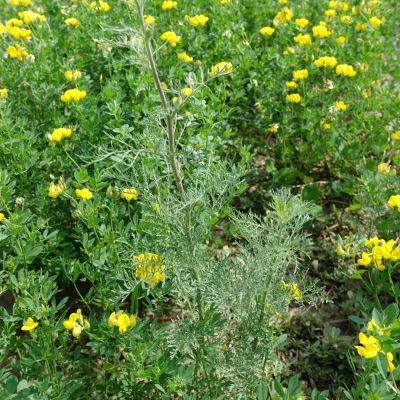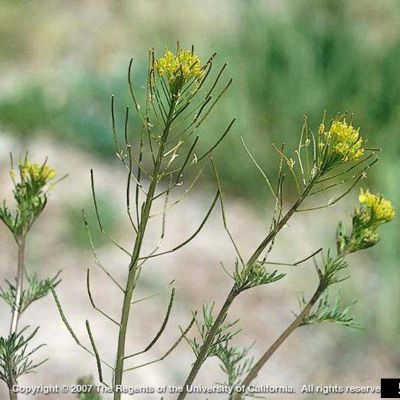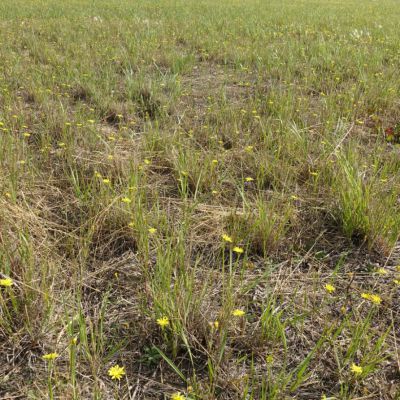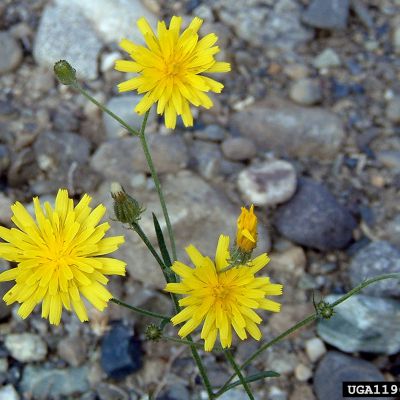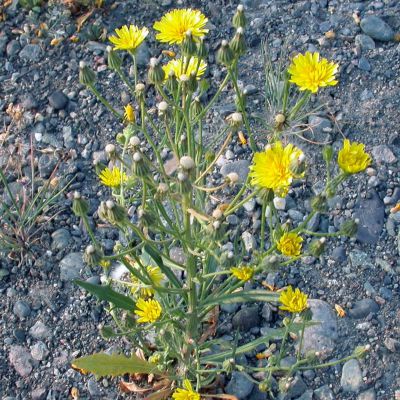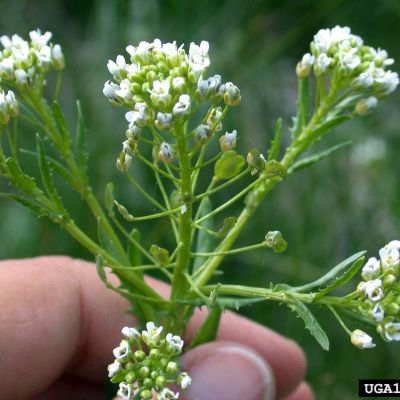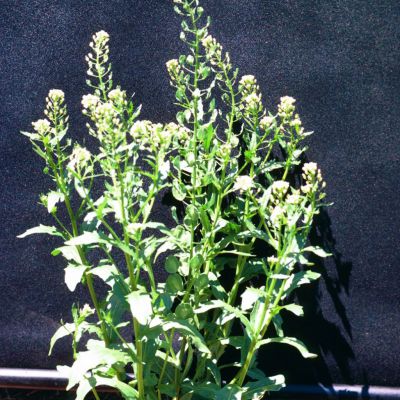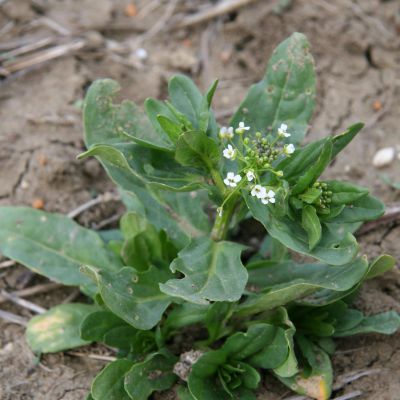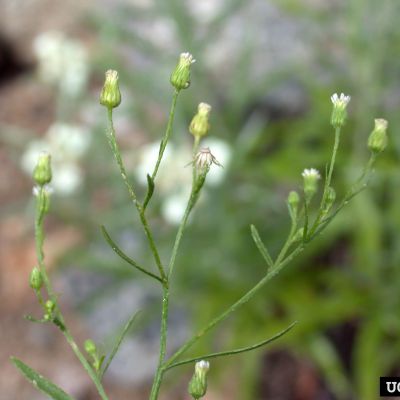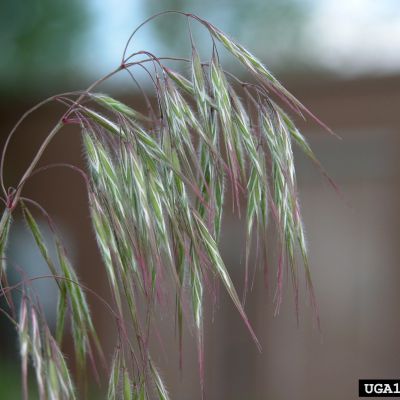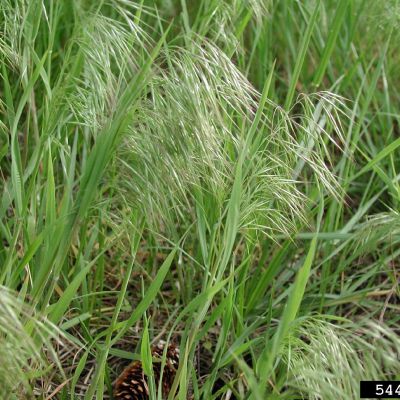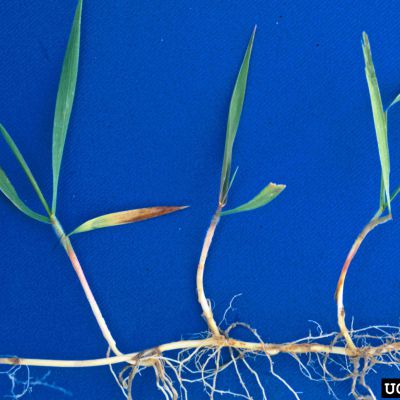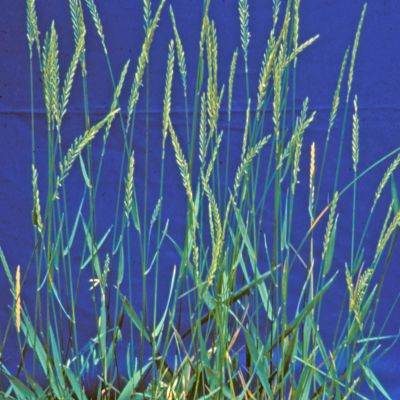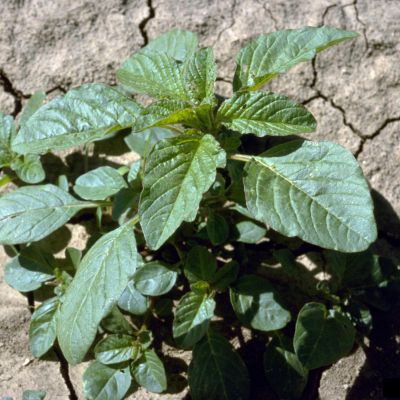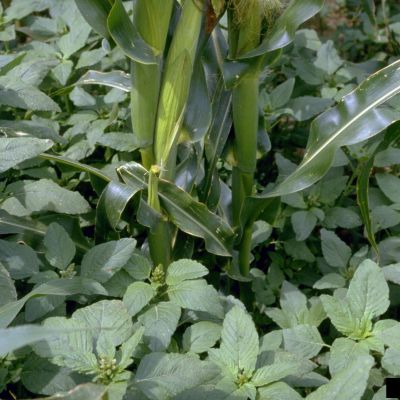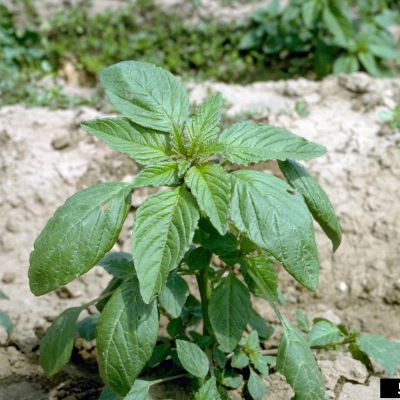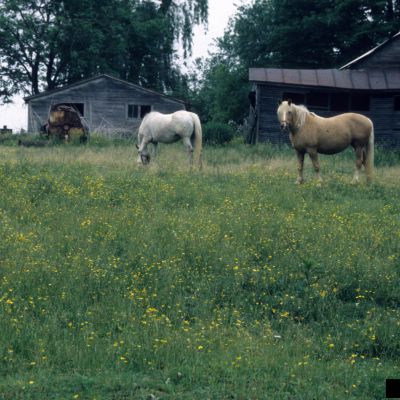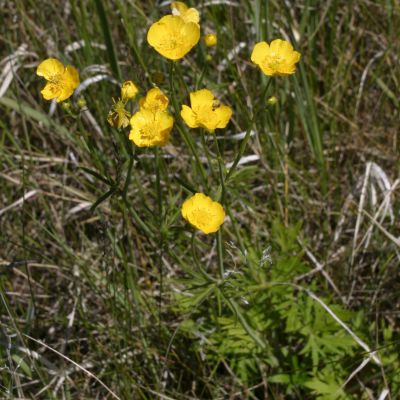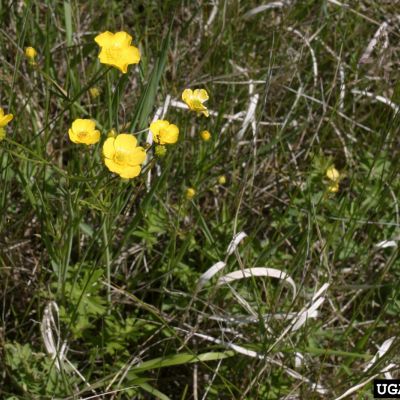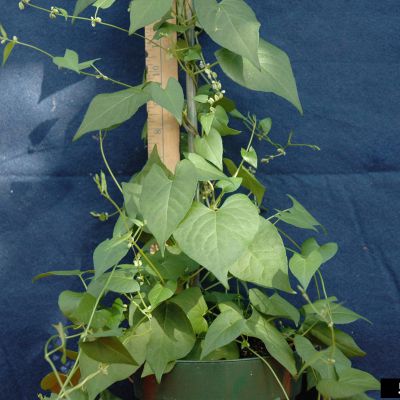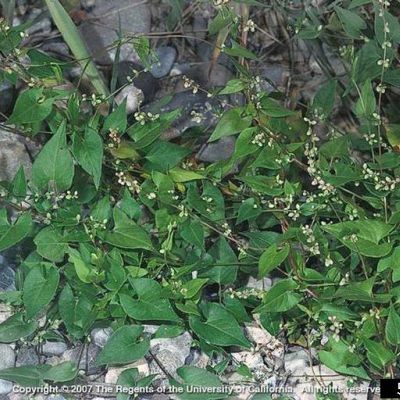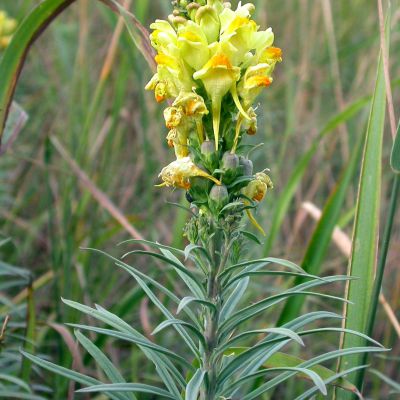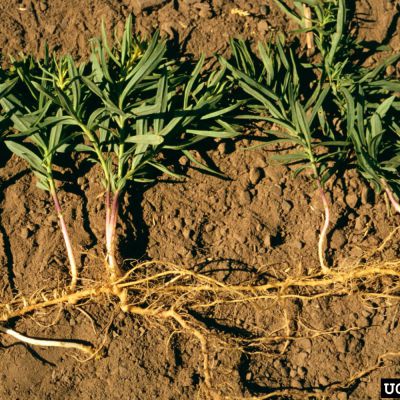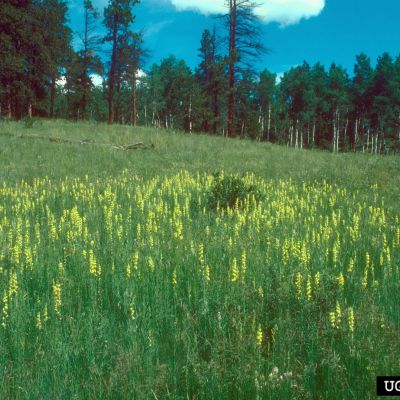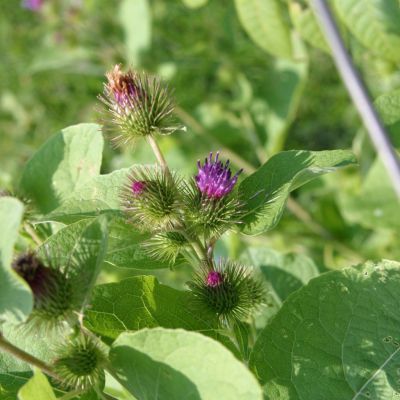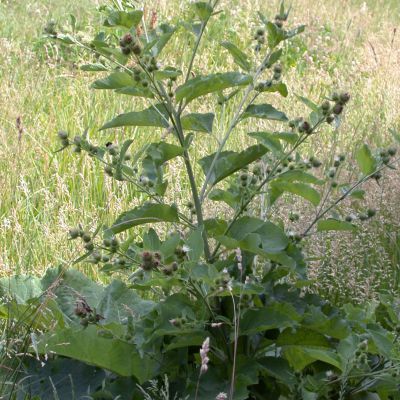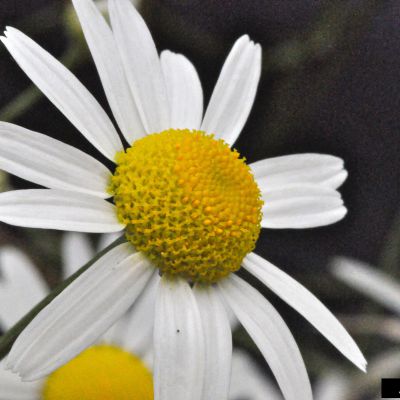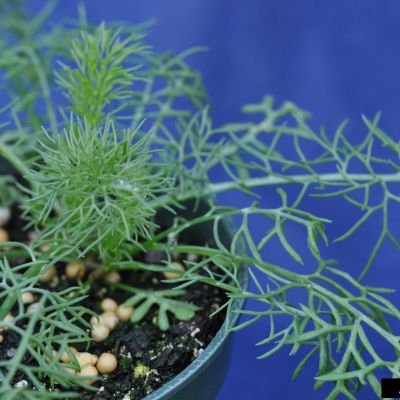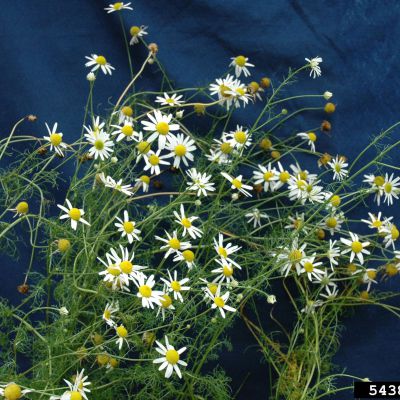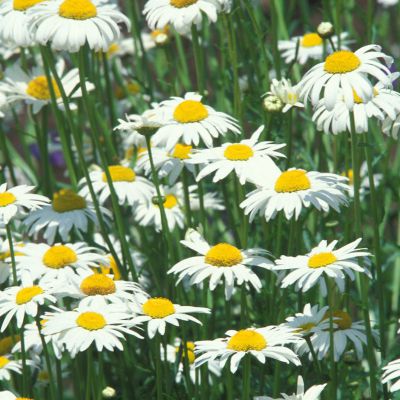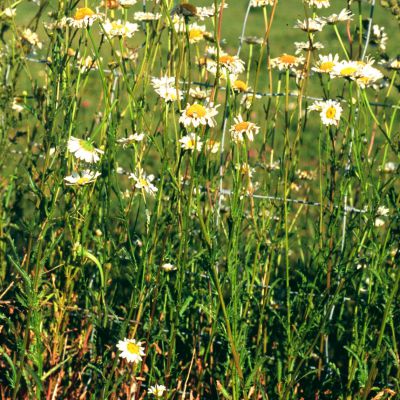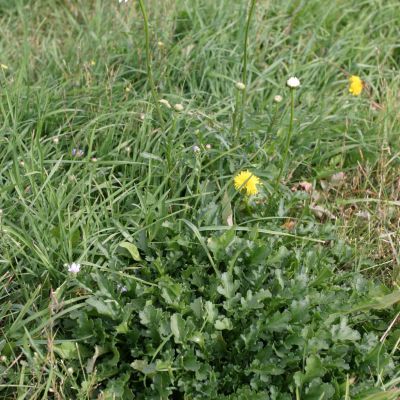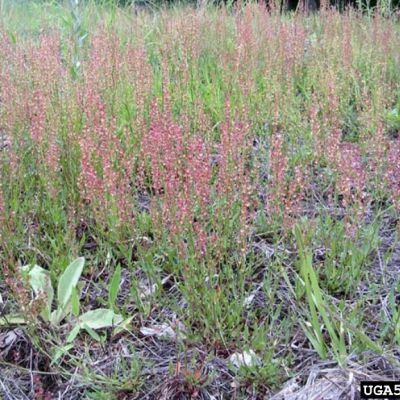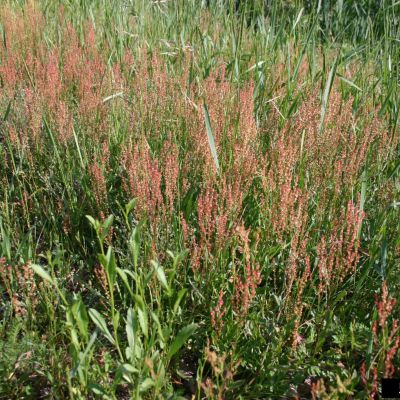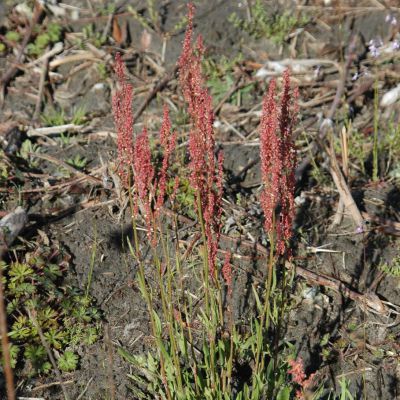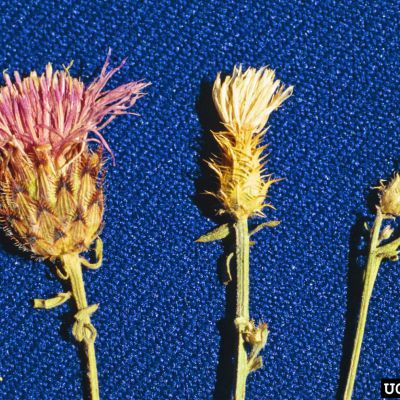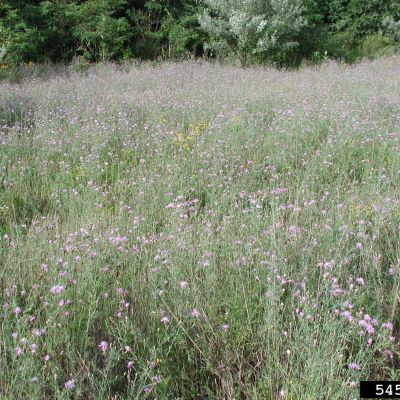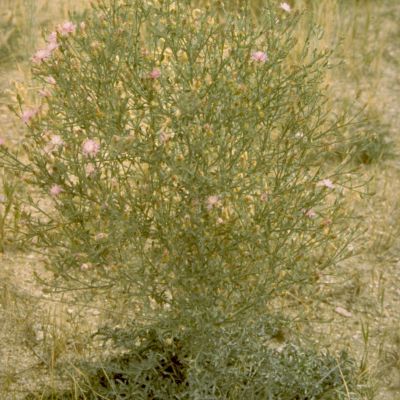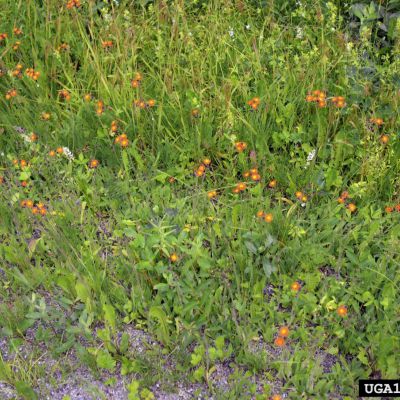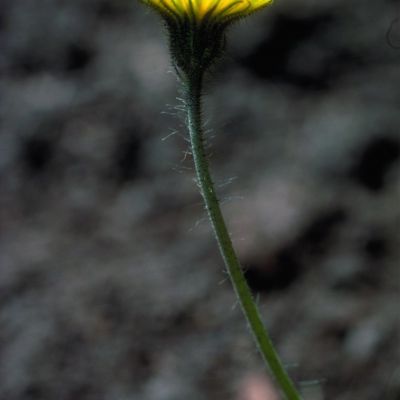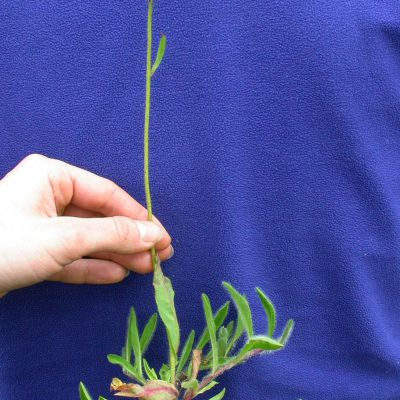Forage Weed Management
Weed Apps and Sites
- Association of Alberta Agriculture Fieldmen – (weed ID) – iOS | Android
- WeedsBMP (for Rangelands- British Columbia) – iOS | Android
- PlantWise – Invasive Species Council of British Columbia – iOS | Android
- Savvy Weed ID & Control – iOS | Android
- EDDMapS Alberta or EDDMapS Ontario (does assist with ID) – iOS | Android
- Weed ID (Monsanto Canada – assists with weed ID) – iOS | Android
- Imap Invasives – (Sask geo-locate and reporting) – iOS | Android
- Pesticide Labels App (Government of Canada) – iOS | Android
- Report a Weed (BC weed geo-locate and reporting) – iOS | Android
- Xarvio Scouting – iOS | Android
Provincial Invasive Species Councils
Weeds in Forages Information
- Saskatchewan Invasive Plant Species Guide– Saskatchewan Forage Council
- Identification Guide for Alberta Invasive Plants – Prohibited Noxious and Noxious – Alberta Agriculture & Wheatland County.
- Guide to Weeds in British Columbia (2002 press. book) – Contact Government of BC for purchase.
- Field Guide to Noxious Weeds and Other Selected Invasive Plants of BC- Invasive Species Council of BC.
- Weed Seedling Identification Guide– for Montana & Northern Great Plains – Provincial printed guides may also be available through your Provincial Ministry of Agriculture.
- Weeds of the Prairies – Free Download
- Integrated Pest Management– an overview
- Weeds & Management– Manitoba Agriculture
- Benefiting from the Power of First Cut; Have a Game Plan for Weeds – Perennia, Atlantic Canada
- Grasslands Ontario
- Identification Guide to Weeds in Quebec
Guide to Crop Protection
Top Weeds
British Columbia Zones
Please refer to the WeedsBMP app for weeds of importance to rangelands and forages in British Columbia.
Black
During Establishment (0-2 yrs)
-
Kochia Kochia
Bassia scoparia
- Annual plant; greyish-green leaves with thick soft hairs; almost furry in appearance; grows taller and very branched as matures; some stems have purplish tones.
- Patch tillage or hand pulling; mowing can reduce seed set; herbicide control at rosette stage early in the spring. Most biotypes are Group 2 resistant and biotypes have been found that are resistant to glyphosate and Group 4 herbicides like dicamba, and fluroxypyr.
- Weeds of the Prairies
WeedsBMP App BC – iOS | Android
Photos
-
Perennial Sow Thistle Perennial Sow Thistle
Sonchus arvensis
- Extensive creeping-rooted perennial with yellow dandelion-like flowers on tall stems; prickly leaves
- Herbicide control at pre-bud stage; repeatitive mowing can control seed production; trained livestock grazing.
- Identification Guide for Alberta Invasive Plants
Weeds of the Prairies
WeedsBMP App BC – iOS | Android
Photos
-
Dandelion (common) Dandelion (common)
Taraxacum officinale
- Perennial with deep tap root; single yellow flower head on top of hollow leafless stem; leaves are basal; prolific seed producer.
- Control prior to seeding with fall herbicide treatments; herbicide control in grasses; difficult to control in alfalfa without renovating stands.
- Weeds of the Prairies
Photos
-
Foxtail Barley Foxtail Barley
Hordeum jubatum
- perennial grass with dense fiberous roots; grows in a tuft; greyish-green leaves; barley-like awned seed heads; salt, flooding and drought tolerant.
- Establishing forages that outcompete foxtail barley; patch tillage; herbicide control prior to seeding.
- Weeds of the Prairies
WeedsBMP App BC – iOS | Android
Photos
-
Volunteer Canola Volunteer Canola
Brassica napus
- Annual field crop which has become weedy; basal rosettes; stems bolt upwards and branch outwards with many yellow 4 petal flowers
- Mowing to prevent seed set; grazing; herbicide control before bolting- note glyphosate is often infective.
- Weeds of the Prairies
Photos
In Established Stands
-
Absinthe Wormwood Absinthe Wormwood
Artemisia absinthium
- greenish-grey, multi-stemmed perennial with tap root growth; top growth dies back yearly; strong pungent smell
- Herbicide control while plants are still green and actively growing.
- Saskatchewan Invasive Plant Species Guide
Identification Guide for Alberta Invasive Plants
Weeds of the Prairies
Photos
-
Canada Thistle Canada Thistle
Cirsium arvense
- A perennial thistle with tap root and extensive creeping root system; grows in patches which can spread quickly; plants are either male or female.
- Grazing (early season); timed herbicide control with selective Group 4 herbicides; mowing repeatedly to prevent seedset and deplete root reserves; biological controls released but are largely ineffective.
- Identification Guide for Alberta Invasive Plants
Weeds of the Prairies
WeedsBMP App BC – iOS | Android
Photos
-
Common Tansy Common Tansy
Tanacetum vulgare
- Aromatic, perennial with tap and short creeping root system; deep green distinctly lobed leaves, distinct flat-topped, yellow button-like flowers; certain populations can cause cattle to spontaneously abort.
- Mowing to prevent seed set; herbicide control when green and actively growing.
- Saskatchewan Invasive Plant Species Guide
Identification Guide for Alberta Invasive Plants
Weeds of the Prairies
WeedsBMP App BC – iOS | Android
Photos
-
Nodding Thistle Nodding Thistle
Carduus nutans
- Biennial thistle with long tap root; thorny leaves fuse with the stem to create a winged stem; large magenta nodding flower heads on top of slightly branched plant.
- Hand pulling or mowing can stop seed set; herbicide control before seed set; biological controls are effective
- Saskatchewan Invasive Plant Species Guide
Identification Guide for Alberta Invasive Plants
WeedsBMP App BC – iOS | Android
Photos
-
Leafy Spurge Leafy Spurge
Euphorbia esula
- Perennial with taproot and extensive creeping root system; stems unbranched until flowering; distinct yellowish-green bracts emerge early on plant tops; pods explode propelling seeds.
- Herbicide control and targeted grazing (i.e. sheep & goats) can be effective; biological control agents are available; early mowing will reduce seed set.
- Saskatchewan Invasive Plant Species Guide
Identification Guide for Alberta Invasive Plants
WeedsBMP App BC – iOS | Android
Photos
Brown
During Establishment (0-2 yrs)
-
Kochia Kochia
Bassia scoparia
- Annual plant; greyish-green leaves with thick soft hairs; almost furry in appearance; grows taller and very branched as matures; some stems have purplish tones.
- Patch tillage or hand pulling; mowing can reduce seed set; herbicide control at rosette stage early in the spring. Most biotypes are Group 2 resistant and biotypes have been found that are resistant to glyphosate and Group 4 herbicides like dicamba, and fluroxypyr.
- Weeds of the Prairies
WeedsBMP App BC – iOS | Android
Photos
-
Flixweed Flixweed
Descurainia sophia
- Annual or winter annual; starts in a basal rosette with a branched stem; finely divided grey-green leaves; multiple tiny yellow flowers on short stalks at stem tips; tansy mustard is similar.
- Mowing; patch tillage or hand pulling; hebicide control at seedling stage.
- Weeds of the Prairies
WeedsBMP App BC – iOS | Android
Photos
-
Narrow-Leaved Hawksbeard Narrow-Leaved Hawksbeard
Crepis tectorum
- Annual or winter annual; basal rosette with narrow “grass-like” leaves; the stems have milky; stems are usually branched with yellow dandelion-like flowers in clusters at the tops of branches; seeds are windblown.
- Timed mowing right after bolting; herbicide control (fall most effective); some biotypes are Group 2 herbicide resistant.
- Weeds of the Prairies
Photos
-
Stinkweed Stinkweed
Thlaspi arvense
- Prolific seed producing annual or winter annual; basal rosette grows to a small plant producing white flowers and then flat seedpods; turnipy- garlicy smell; winter annuals mature very early.
- Herbicide control before flowering; patch tillage; mowing.
- Weeds of the Prairies
Photos
-
Canada Fleabane Canada Fleabane
Erigeron canadensis
- Winter annual or biennial; numerous fluffy looking flower heads on branches; strong carrot-like smell; hairy stems and “mitten-shaped” leaves.
- Herbicides in the rosette stage (fall); mowing at bolting in the second year of growth.
- Weeds of the Prairies
Photos
In Established Stands
-
Downy Brome Downy Brome
Bromus tectorum
- Annual or winter annual grass; drooping seed heads with straight long-awned seeds; similar to Japanese brome.
- Early spring grazing; repeated mowing season-long; herbicide control before flowering; hand pulling
- Saskatchewan Invasive Plant Species Guide
Weeds of the Prairies
WeedsBMP App BC – iOS | Android
Photos
-
Japanese Brome Japanese Brome
Bromus japonicus
- Annual or sometimes winter annual grass slightly drooping seed heads with curved short-awned spikelets that resemble a cereal head; similar to downy brome.
- Grazing; repeated mowing season-long; herbicide control before flowering; hand pulling
- Saskatchewan Invasive Plant Species Guide
Identification Guide for Alberta Invasive Plants
Weeds of the Prairies
WeedsBMP App BC – iOS | Android
-
Dandelion (common) Dandelion (common)
Taraxacum officinale
- Perennial with deep tap root; single yellow flower head on top of hollow leafless stem; leaves are basal; prolific seed producer.
- Control prior to seeding with fall herbicide treatments; herbicide control in grasses; difficult to control in alfalfa without renovating stands.
- Weeds of the Prairies
Photos
-
Canada Thistle Canada Thistle
Cirsium arvense
- A perennial thistle with tap root and extensive creeping root system; grows in patches which can spread quickly; plants are either male or female.
- Grazing (early season); timed herbicide control with selective Group 4 herbicides; mowing repeatedly to prevent seedset and deplete root reserves; biological controls released but are largely ineffective.
- Identification Guide for Alberta Invasive Plants
Weeds of the Prairies
WeedsBMP App BC – iOS | Android
Photos
-
Kochia Kochia
Bassia scoparia
- Annual plant; greyish-green leaves with thick soft hairs; almost furry in appearance; grows taller and very branched as matures; some stems have purplish tones.
- Patch tillage or hand pulling; mowing can reduce seed set; herbicide control at rosette stage early in the spring. Most biotypes are Group 2 resistant and biotypes have been found that are resistant to glyphosate and Group 4 herbicides like dicamba, and fluroxypyr.
- Weeds of the Prairies
WeedsBMP App BC – iOS | Android
Photos
-
Foxtail Barley Foxtail Barley
Hordeum jubatum
- perennial grass with dense fiberous roots; grows in a tuft; greyish-green leaves; barley-like awned seed heads; salt, flooding and drought tolerant.
- Establishing forages that outcompete foxtail barley; patch tillage; herbicide control prior to seeding.
- Weeds of the Prairies
WeedsBMP App BC – iOS | Android
Photos
Dark Brown
During Establishment (0-2 yrs)
-
Kochia Kochia
Bassia scoparia
- Annual plant; greyish-green leaves with thick soft hairs; almost furry in appearance; grows taller and very branched as matures; some stems have purplish tones.
- Patch tillage or hand pulling; mowing can reduce seed set; herbicide control at rosette stage early in the spring. Most biotypes are Group 2 resistant and biotypes have been found that are resistant to glyphosate and Group 4 herbicides like dicamba, and fluroxypyr.
- Weeds of the Prairies
WeedsBMP App BC – iOS | Android
Photos
-
Perennial Sow Thistle Perennial Sow Thistle
Sonchus arvensis
- Extensive creeping-rooted perennial with yellow dandelion-like flowers on tall stems; prickly leaves
- Herbicide control at pre-bud stage; repeatitive mowing can control seed production; trained livestock grazing.
- Identification Guide for Alberta Invasive Plants
Weeds of the Prairies
WeedsBMP App BC – iOS | Android
Photos
-
Dandelion (common) Dandelion (common)
Taraxacum officinale
- Perennial with deep tap root; single yellow flower head on top of hollow leafless stem; leaves are basal; prolific seed producer.
- Control prior to seeding with fall herbicide treatments; herbicide control in grasses; difficult to control in alfalfa without renovating stands.
- Weeds of the Prairies
Photos
-
Foxtail Barley Foxtail Barley
Hordeum jubatum
- perennial grass with dense fiberous roots; grows in a tuft; greyish-green leaves; barley-like awned seed heads; salt, flooding and drought tolerant.
- Establishing forages that outcompete foxtail barley; patch tillage; herbicide control prior to seeding.
- Weeds of the Prairies
WeedsBMP App BC – iOS | Android
Photos
-
Narrow-Leaved Hawksbeard Narrow-Leaved Hawksbeard
Crepis tectorum
- Annual or winter annual; basal rosette with narrow “grass-like” leaves; the stems have milky; stems are usually branched with yellow dandelion-like flowers in clusters at the tops of branches; seeds are windblown.
- Timed mowing right after bolting; herbicide control (fall most effective); some biotypes are Group 2 herbicide resistant.
- Weeds of the Prairies
Photos
In Established Stands
-
Absinthe Wormwood Absinthe Wormwood
Artemisia absinthium
- greenish-grey, multi-stemmed perennial with tap root growth; top growth dies back yearly; strong pungent smell
- Herbicide control while plants are still green and actively growing.
- Saskatchewan Invasive Plant Species Guide
Identification Guide for Alberta Invasive Plants
Weeds of the Prairies
Photos
-
Dandelion (common) Dandelion (common)
Taraxacum officinale
- Perennial with deep tap root; single yellow flower head on top of hollow leafless stem; leaves are basal; prolific seed producer.
- Control prior to seeding with fall herbicide treatments; herbicide control in grasses; difficult to control in alfalfa without renovating stands.
- Weeds of the Prairies
Photos
-
Common Tansy Common Tansy
Tanacetum vulgare
- Aromatic, perennial with tap and short creeping root system; deep green distinctly lobed leaves, distinct flat-topped, yellow button-like flowers; certain populations can cause cattle to spontaneously abort.
- Mowing to prevent seed set; herbicide control when green and actively growing.
- Saskatchewan Invasive Plant Species Guide
Identification Guide for Alberta Invasive Plants
Weeds of the Prairies
WeedsBMP App BC – iOS | Android
Photos
-
Canada Thistle Canada Thistle
Cirsium arvense
- A perennial thistle with tap root and extensive creeping root system; grows in patches which can spread quickly; plants are either male or female.
- Grazing (early season); timed herbicide control with selective Group 4 herbicides; mowing repeatedly to prevent seedset and deplete root reserves; biological controls released but are largely ineffective.
- Identification Guide for Alberta Invasive Plants
Weeds of the Prairies
WeedsBMP App BC – iOS | Android
Photos
-
Quackgrass Quackgrass
Elymus repens
- Fast spreading rhizomatous creeping perennial grass; leaf auricles clasp the stem; leaves can be rough and slightly hairy; leaves sparse up the stem as plants mature; seedheads similar to native wheatgrasses
- Difficult to control without renovating the stand with glyphosate based herbicides.
- Weeds of the Prairies
WeedsBMP App BC – iOS | Android
Photos
Dark Grey
During Establishment (0-2 yrs)
-
Stinkweed Stinkweed
Thlaspi arvense
- Prolific seed producing annual or winter annual; basal rosette grows to a small plant producing white flowers and then flat seedpods; turnipy- garlicy smell; winter annuals mature very early.
- Herbicide control before flowering; patch tillage; mowing.
- Weeds of the Prairies
Photos
-
Redroot Pigweed Redroot Pigweed
Amaranthus retroflexus
- Annual with a red tap root and base of the plant; leaves nearly diamond shaped with a notched tip and protruding veins; non-showy flowers on the tops of the plant and crotch of the leaves.
- Hand pulling; patch tillage; mowing; herbicide control.
- Weeds of the Prairies
WeedsBMP App BC – iOS | Android
Photos
-
Foxtail Barley Foxtail Barley
Hordeum jubatum
- perennial grass with dense fiberous roots; grows in a tuft; greyish-green leaves; barley-like awned seed heads; salt, flooding and drought tolerant.
- Establishing forages that outcompete foxtail barley; patch tillage; herbicide control prior to seeding.
- Weeds of the Prairies
WeedsBMP App BC – iOS | Android
Photos
-
Kochia Kochia
Bassia scoparia
- Annual plant; greyish-green leaves with thick soft hairs; almost furry in appearance; grows taller and very branched as matures; some stems have purplish tones.
- Patch tillage or hand pulling; mowing can reduce seed set; herbicide control at rosette stage early in the spring. Most biotypes are Group 2 resistant and biotypes have been found that are resistant to glyphosate and Group 4 herbicides like dicamba, and fluroxypyr.
- Weeds of the Prairies
WeedsBMP App BC – iOS | Android
Photos
-
Canada Thistle Canada Thistle
Cirsium arvense
- A perennial thistle with tap root and extensive creeping root system; grows in patches which can spread quickly; plants are either male or female.
- Grazing (early season); timed herbicide control with selective Group 4 herbicides; mowing repeatedly to prevent seedset and deplete root reserves; biological controls released but are largely ineffective.
- Identification Guide for Alberta Invasive Plants
Weeds of the Prairies
WeedsBMP App BC – iOS | Android
Photos
In Established Stands
-
Woody Species (Aspen, Willow & Western Snowberry) Woody Species (Aspen, Willow & Western Snowberry)
- Woody perennials expand outwards from existing patches when newly established perennial forages are adjacent; often annual cropping previously slowed infestations.
- Control timing is species dependant. Effective control includes: mowing; targeted grazing; burning; herbicide control early summer.
-
Dandelion (common) Dandelion (common)
Taraxacum officinale
- Perennial with deep tap root; single yellow flower head on top of hollow leafless stem; leaves are basal; prolific seed producer.
- Control prior to seeding with fall herbicide treatments; herbicide control in grasses; difficult to control in alfalfa without renovating stands.
- Weeds of the Prairies
Photos
-
Perennial Sow Thistle Perennial Sow Thistle
Sonchus arvensis
- Extensive creeping-rooted perennial with yellow dandelion-like flowers on tall stems; prickly leaves
- Herbicide control at pre-bud stage; repeatitive mowing can control seed production; trained livestock grazing.
- Identification Guide for Alberta Invasive Plants
Weeds of the Prairies
WeedsBMP App BC – iOS | Android
Photos
-
Common Tansy Common Tansy
Tanacetum vulgare
- Aromatic, perennial with tap and short creeping root system; deep green distinctly lobed leaves, distinct flat-topped, yellow button-like flowers; certain populations can cause cattle to spontaneously abort.
- Mowing to prevent seed set; herbicide control when green and actively growing.
- Saskatchewan Invasive Plant Species Guide
Identification Guide for Alberta Invasive Plants
Weeds of the Prairies
WeedsBMP App BC – iOS | Android
Photos
-
Tall Buttercup Tall Buttercup
Ranunculus acris
- Creeping perennial with glossy five petal yellow flowers on stems up to 1 meter tall; hairy leaves.
- Herbicide control can be effective; maintain pasture health to prevent establishment.
- Identification Guide for Alberta Invasive Plants
Weeds of the Prairies
Photos
Grey
During Establishment (0-2 yrs)
-
Foxtail Barley Foxtail Barley
Hordeum jubatum
- perennial grass with dense fiberous roots; grows in a tuft; greyish-green leaves; barley-like awned seed heads; salt, flooding and drought tolerant.
- Establishing forages that outcompete foxtail barley; patch tillage; herbicide control prior to seeding.
- Weeds of the Prairies
WeedsBMP App BC – iOS | Android
Photos
-
Renouée liseron Renouée liseron
Fallopia convolvulus
- Tap rooted annual; twining stem with arrow shaped leaves; grows low along the ground.
- Herbicide control early in the growing season; hand pulling.
- Weeds of the Prairies
Photos
-
Dandelion (common) Dandelion (common)
Taraxacum officinale
- Perennial with deep tap root; single yellow flower head on top of hollow leafless stem; leaves are basal; prolific seed producer.
- Control prior to seeding with fall herbicide treatments; herbicide control in grasses; difficult to control in alfalfa without renovating stands.
- Weeds of the Prairies
Photos
-
Canada Thistle Canada Thistle
Cirsium arvense
- A perennial thistle with tap root and extensive creeping root system; grows in patches which can spread quickly; plants are either male or female.
- Grazing (early season); timed herbicide control with selective Group 4 herbicides; mowing repeatedly to prevent seedset and deplete root reserves; biological controls released but are largely ineffective.
- Identification Guide for Alberta Invasive Plants
Weeds of the Prairies
WeedsBMP App BC – iOS | Android
Photos
-
Flixweed Flixweed
Descurainia sophia
- Annual or winter annual; starts in a basal rosette with a branched stem; finely divided grey-green leaves; multiple tiny yellow flowers on short stalks at stem tips; tansy mustard is similar.
- Mowing; patch tillage or hand pulling; hebicide control at seedling stage.
- Weeds of the Prairies
WeedsBMP App BC – iOS | Android
Photos
In Established Stands
-
Woody Species (Aspen, Willow & Western Snowberry) Woody Species (Aspen, Willow & Western Snowberry)
- Woody perennials expand outwards from existing patches when newly established perennial forages are adjacent; often annual cropping previously slowed infestations.
- Control timing is species dependant. Effective control includes: mowing; targeted grazing; burning; herbicide control early summer.
-
Common Tansy Common Tansy
Tanacetum vulgare
- Aromatic, perennial with tap and short creeping root system; deep green distinctly lobed leaves, distinct flat-topped, yellow button-like flowers; certain populations can cause cattle to spontaneously abort.
- Mowing to prevent seed set; herbicide control when green and actively growing.
- Saskatchewan Invasive Plant Species Guide
Identification Guide for Alberta Invasive Plants
Weeds of the Prairies
WeedsBMP App BC – iOS | Android
Photos
-
Yellow Toadflax Yellow Toadflax
Linaria vulgaris
- Perennial with tap root and creeping root; snapdragon-like flower heads; produces clear juice from broken leaves; unbranched stems until flowering; narrow leaves attach directly to stems.
- Herbicide control mid-summer; biological controls; repeated patch tillage.
- Saskatchewan Invasive Plant Species Guide
Identification Guide for Alberta Invasive Plants
Weeds of the Prairies
WeedsBMP App BC – iOS | Android
Photos
-
Absinthe Wormwood Absinthe Wormwood
Artemisia absinthium
- greenish-grey, multi-stemmed perennial with tap root growth; top growth dies back yearly; strong pungent smell
- Herbicide control while plants are still green and actively growing.
- Saskatchewan Invasive Plant Species Guide
Identification Guide for Alberta Invasive Plants
Weeds of the Prairies
Photos
-
Common Burdock / Lesser Burdock Common Burdock / Lesser Burdock
Arctium minus
- Tap rooted biennial; large heart-shaped basal leaves; large alternate leaves; large burs impact livestock production; seeds are short lived.
- Herbicide control or hand pulling in rosette stage (first years growth) before bolting and flowering; mow or sheer the tap root at bolting.
- Saskatchewan Invasive Plant Species Guide
Weeds of the Prairies
WeedsBMP App BC – iOS | Android
Photos
-
Tall Buttercup Tall Buttercup
Ranunculus acris
- Creeping perennial with glossy five petal yellow flowers on stems up to 1 meter tall; hairy leaves.
- Herbicide control can be effective; maintain pasture health to prevent establishment.
- Identification Guide for Alberta Invasive Plants
Weeds of the Prairies
Photos
Peace River
During Establishment (0-2 yrs)
-
Camomille inodore Camomille inodore
Scentless Chamomile
Tripleurospermum inodorum
- Annual, winter annual, biennial, or short lived perennial; dense fibrous roots; white daisy-like flowers and greatly divided lacy leaves.
- Hand pulling before flowering; repeated patch tillage or repeated mowing passes (may regrow from lower stem buds); herbicide control before flowering; biological control.
- Saskatchewan Invasive Plant Species Guide
Identification Guide for Alberta Invasive Plants
Weeds of the Prairies
WeedsBMP App BC – iOS | Android
Photos
-
Oxeye Daisy Oxeye Daisy
Leucanthemum vulgare
- Shallow rooted perennial plant with white daisy-like flowers; numerous slightly curving stems from one base; spatual shaped leaves with noticable scallops.
- Herbicide control before flowering; hand pulling, mowing or deadhead (pull the flower off) to prevent seed set; trained livestock grazing.
- Saskatchewan Invasive Plant Species Guide
Identification Guide for Alberta Invasive Plants
Weeds of the Prairies
WeedsBMP App BC – iOS | Android
Photos
-
Narrow-Leaved Hawksbeard Narrow-Leaved Hawksbeard
Crepis tectorum
- Annual or winter annual; basal rosette with narrow “grass-like” leaves; the stems have milky; stems are usually branched with yellow dandelion-like flowers in clusters at the tops of branches; seeds are windblown.
- Timed mowing right after bolting; herbicide control (fall most effective); some biotypes are Group 2 herbicide resistant.
- Weeds of the Prairies
Photos
-
Renouée liseron Renouée liseron
Fallopia convolvulus
- Tap rooted annual; twining stem with arrow shaped leaves; grows low along the ground.
- Herbicide control early in the growing season; hand pulling.
- Weeds of the Prairies
Photos
-
Ovin Oseille Ovin Oseille
Rumex acetosella
- Annual or perennial creeping plant; arrow-shaped basal leaves; stems to 30 cm long with long smooth leaves; tiny light orange to red flowers are in panicles on the stem end; produces large seedbank.
- Hand pulling; repeated patch tillage; herbicide control early in the growing season.
- WeedsBMP App BC – iOS | Android
Photos
In Established Stands
-
Centaurées (diffuses et tachetées et russes) Centaurées (diffuses et tachetées et russes)
Centaurea diffusa & Centaurea stoebe & Rhaponticum repens
- Biennial (diffuse) or perennial (spotted & Russian) with long tap root; deeply lobed leaves; contain allelopathic chemicals that supress growth of other plants; spotted knapweed has pink to purple-coloured flowers while diffuse has white flowers; Russian knapweed has white to pink flowers with membranous bracts.
- Hand pulling; herbicide control early in the growing season while still green; biological control agents; trained livestock grazing.
- Saskatchewan Invasive Plant Species Guide
Identification Guide for Alberta Invasive Plants
Weeds of the Prairies
WeedsBMP App BC – iOS | Android
Photos
-
Canada Thistle Canada Thistle
Cirsium arvense
- A perennial thistle with tap root and extensive creeping root system; grows in patches which can spread quickly; plants are either male or female.
- Grazing (early season); timed herbicide control with selective Group 4 herbicides; mowing repeatedly to prevent seedset and deplete root reserves; biological controls released but are largely ineffective.
- Identification Guide for Alberta Invasive Plants
Weeds of the Prairies
WeedsBMP App BC – iOS | Android
Photos
-
Common Tansy Common Tansy
Tanacetum vulgare
- Aromatic, perennial with tap and short creeping root system; deep green distinctly lobed leaves, distinct flat-topped, yellow button-like flowers; certain populations can cause cattle to spontaneously abort.
- Mowing to prevent seed set; herbicide control when green and actively growing.
- Saskatchewan Invasive Plant Species Guide
Identification Guide for Alberta Invasive Plants
Weeds of the Prairies
WeedsBMP App BC – iOS | Android
Photos
-
Yellow Toadflax Yellow Toadflax
Linaria vulgaris
- Perennial with tap root and creeping root; snapdragon-like flower heads; produces clear juice from broken leaves; unbranched stems until flowering; narrow leaves attach directly to stems.
- Herbicide control mid-summer; biological controls; repeated patch tillage.
- Saskatchewan Invasive Plant Species Guide
Identification Guide for Alberta Invasive Plants
Weeds of the Prairies
WeedsBMP App BC – iOS | Android
Photos
-
Hawkweed (Meadow or Yellow & Orange) Hawkweed (Meadow or Yellow & Orange)
Pilosella caespitosa & Pilosella aurantiaca
- Perennials with fibrous roots and creeping, leafy stolons; densly hairy leaves and stems; yellow or orange dandelion-like flowers
- Hand pulling; herbicide control on actively growing plants.
- Saskatchewan Invasive Plant Species Guide
Identification Guide for Alberta Invasive Plants
WeedsBMP App BC – iOS | Android
Photos
Northwest Ontario
Top 10 Weeds in Forages
-
Lamb’s Quarters Lamb’s Quarters
Chenopodium album
Annual, reproducing only by seed. Very variable in appearance. Seedlings: Cotyledons are narrowly elliptic, 12- 15 mm (4- 6 in.) long; upper surface is dull green, maroon on the underside; Mealy grey coating on young leaves; First 2 or 4 true leaves apparently opposite (2 per node); 20- 200 cm (8 in.-6½ ft) high. Stems: Branched or unbranched; Smooth; Green or with reddish or purplish lengthwise stripes and ridges. Leaves: All later leaves and branches distinctly alternate (1 per node); Stalked; Blades 3- 10 cm (1- 4 in.) long; Lance-shaped or more often broadly triangular; Irregular; usually shallow teeth; Green or greyish due to a covering of a white mealiness or powderiness, sometimes with reddish undersurface on young plants.
-
Shepard’s Purse Shepard’s Purse
Capsella bursa pastoris
Shepherd’s purse is an annual or winter annual weed reproducing only by seed. Seedlings: Lobed basal leaves; Hairy lobes; Lobes or divisions are more or less uniform on each side; Can produce over 33,000 seeds per plant. Stems: Stems are erect; Stems extend 10 – 60 cm high; Stems are branched above or throughout. Leaves: Grows from a rosette of lobed leaves at base; Leafs are alternate (1 per node); The blades are very variable; The leaf blades are oblong and 5 – 10 cm long; Shallowly to deeply and coarsely toothed.
-
Redroot Pigweed Redroot Pigweed
Amaranthus retroflexus
- Annual with a red tap root and base of the plant; leaves nearly diamond shaped with a notched tip and protruding veins; non-showy flowers on the tops of the plant and crotch of the leaves.
- Hand pulling; patch tillage; mowing; herbicide control.
- Weeds of the Prairies
WeedsBMP App BC – iOS | Android
Photos
-
Quackgrass Quackgrass
Elymus repens
- Fast spreading rhizomatous creeping perennial grass; leaf auricles clasp the stem; leaves can be rough and slightly hairy; leaves sparse up the stem as plants mature; seedheads similar to native wheatgrasses
- Difficult to control without renovating the stand with glyphosate based herbicides.
- Weeds of the Prairies
WeedsBMP App BC – iOS | Android
Photos
-
Canada Thistle Canada Thistle
Cirsium arvense
- A perennial thistle with tap root and extensive creeping root system; grows in patches which can spread quickly; plants are either male or female.
- Grazing (early season); timed herbicide control with selective Group 4 herbicides; mowing repeatedly to prevent seedset and deplete root reserves; biological controls released but are largely ineffective.
- Identification Guide for Alberta Invasive Plants
Weeds of the Prairies
WeedsBMP App BC – iOS | Android
Photos
-
Broad-leaved plantain Broad-leaved plantain
Plantago major
Perennial, reproducing only by seed. Seedlings: Seedling with rosette; Leaves alternate; Cotyledons oblong to elongated. Leaves: Leaves all in a basal rosette; Oval or elliptic; 5- 30 cm (2- 12 in.) long; The blade about as long as its thick green stalk; Smooth or somewhat rough-hairy; 3 to several prominent veins radiating from the leafstalk towards the tip; Margins smooth or irregularly toothed
-
Common ragweed Common ragweed
Ambrosia artemisiifolia
Annual, reproducing only by seed. Seedlings: Cotyledons are thick, dark green, rounded above, narrowed near the base, sometimes with purple spots near the margins; First leaves are alternate; opposite by the fourth node. Stems: Erect; 15- 150 com (6- 60 in.) high; Usually much-branched; Hairless or hairy throughout; Lower leaves opposite (2 per node); becoming alternate (1 per node) higher on the plant; Bright green to slightly yellowish-green on young plants; becoming greyish-green on older plants; Compound and finely divided, the final divisions usually coarsely toothed.
-
Mouse-eared Chickweed Mouse-eared Chickweed
Cerastium fontanum
Annual or more usually perennial. Reproducing by seed and by horizontal stems which root at the nodes and form dense patches. Seedlings: Seedling with stem; Leaves opposite. Stems: Nearly prostrate; As much as 50 cm (20 in.) long; Short upright branches; or stems erect if growing amongst taller plants.; Densely but very finely hairy; Soft; Often slightly sticky to the touch; Dark green; Round in cross-section with swollen nodes. Stems rooting from nodes which touch the ground, plant spreading by this means to form dense, matted patches. Leaves: Opposite (2 per node); Stalkless; Blades ovate (1- 2 cm, 2/5- 4/5 in. long); Covered with hair up to 2 mm (1/12 in.) long (hence the name “mouse-eared”)
-
Tufted vetch Tufted vetch
Vicia cracca
Perennial; reproducing by seed and by spreading underground root-stocks. Stems 40cm-2m (16-80in.) long, weak, wiry, trailing on the ground or climbing on nearby objects. Leaves alternate (1 per node), pinnately compound with 8 to 12 pairs of bristle-tipped leaflets and branching tendrils at the end; the plant climbing by means of these tendrils.
-
Dandelion (common) Dandelion (common)
Taraxacum officinale
- Perennial with deep tap root; single yellow flower head on top of hollow leafless stem; leaves are basal; prolific seed producer.
- Control prior to seeding with fall herbicide treatments; herbicide control in grasses; difficult to control in alfalfa without renovating stands.
- Weeds of the Prairies
Photos
Northern Ontario
Top 10 Weeds in Forages
-
Lamb’s Quarters Lamb’s Quarters
Chenopodium album
Annual, reproducing only by seed. Very variable in appearance. Seedlings: Cotyledons are narrowly elliptic, 12- 15 mm (4- 6 in.) long; upper surface is dull green, maroon on the underside; Mealy grey coating on young leaves; First 2 or 4 true leaves apparently opposite (2 per node); 20- 200 cm (8 in.-6½ ft) high. Stems: Branched or unbranched; Smooth; Green or with reddish or purplish lengthwise stripes and ridges. Leaves: All later leaves and branches distinctly alternate (1 per node); Stalked; Blades 3- 10 cm (1- 4 in.) long; Lance-shaped or more often broadly triangular; Irregular; usually shallow teeth; Green or greyish due to a covering of a white mealiness or powderiness, sometimes with reddish undersurface on young plants.
-
Shepard’s Purse Shepard’s Purse
Capsella bursa pastoris
Shepherd’s purse is an annual or winter annual weed reproducing only by seed. Seedlings: Lobed basal leaves; Hairy lobes; Lobes or divisions are more or less uniform on each side; Can produce over 33,000 seeds per plant. Stems: Stems are erect; Stems extend 10 – 60 cm high; Stems are branched above or throughout. Leaves: Grows from a rosette of lobed leaves at base; Leafs are alternate (1 per node); The blades are very variable; The leaf blades are oblong and 5 – 10 cm long; Shallowly to deeply and coarsely toothed.
-
Redroot Pigweed Redroot Pigweed
Amaranthus retroflexus
- Annual with a red tap root and base of the plant; leaves nearly diamond shaped with a notched tip and protruding veins; non-showy flowers on the tops of the plant and crotch of the leaves.
- Hand pulling; patch tillage; mowing; herbicide control.
- Weeds of the Prairies
WeedsBMP App BC – iOS | Android
Photos
-
Quackgrass Quackgrass
Elymus repens
- Fast spreading rhizomatous creeping perennial grass; leaf auricles clasp the stem; leaves can be rough and slightly hairy; leaves sparse up the stem as plants mature; seedheads similar to native wheatgrasses
- Difficult to control without renovating the stand with glyphosate based herbicides.
- Weeds of the Prairies
WeedsBMP App BC – iOS | Android
Photos
-
Canada Thistle Canada Thistle
Cirsium arvense
- A perennial thistle with tap root and extensive creeping root system; grows in patches which can spread quickly; plants are either male or female.
- Grazing (early season); timed herbicide control with selective Group 4 herbicides; mowing repeatedly to prevent seedset and deplete root reserves; biological controls released but are largely ineffective.
- Identification Guide for Alberta Invasive Plants
Weeds of the Prairies
WeedsBMP App BC – iOS | Android
Photos
-
Broad-leaved plantain Broad-leaved plantain
Plantago major
Perennial, reproducing only by seed. Seedlings: Seedling with rosette; Leaves alternate; Cotyledons oblong to elongated. Leaves: Leaves all in a basal rosette; Oval or elliptic; 5- 30 cm (2- 12 in.) long; The blade about as long as its thick green stalk; Smooth or somewhat rough-hairy; 3 to several prominent veins radiating from the leafstalk towards the tip; Margins smooth or irregularly toothed
-
Common ragweed Common ragweed
Ambrosia artemisiifolia
Annual, reproducing only by seed. Seedlings: Cotyledons are thick, dark green, rounded above, narrowed near the base, sometimes with purple spots near the margins; First leaves are alternate; opposite by the fourth node. Stems: Erect; 15- 150 com (6- 60 in.) high; Usually much-branched; Hairless or hairy throughout; Lower leaves opposite (2 per node); becoming alternate (1 per node) higher on the plant; Bright green to slightly yellowish-green on young plants; becoming greyish-green on older plants; Compound and finely divided, the final divisions usually coarsely toothed.
-
Mouse-eared Chickweed Mouse-eared Chickweed
Cerastium fontanum
Annual or more usually perennial. Reproducing by seed and by horizontal stems which root at the nodes and form dense patches. Seedlings: Seedling with stem; Leaves opposite. Stems: Nearly prostrate; As much as 50 cm (20 in.) long; Short upright branches; or stems erect if growing amongst taller plants.; Densely but very finely hairy; Soft; Often slightly sticky to the touch; Dark green; Round in cross-section with swollen nodes. Stems rooting from nodes which touch the ground, plant spreading by this means to form dense, matted patches. Leaves: Opposite (2 per node); Stalkless; Blades ovate (1- 2 cm, 2/5- 4/5 in. long); Covered with hair up to 2 mm (1/12 in.) long (hence the name “mouse-eared”)
-
Tufted vetch Tufted vetch
Vicia cracca
Perennial; reproducing by seed and by spreading underground root-stocks. Stems 40cm-2m (16-80in.) long, weak, wiry, trailing on the ground or climbing on nearby objects. Leaves alternate (1 per node), pinnately compound with 8 to 12 pairs of bristle-tipped leaflets and branching tendrils at the end; the plant climbing by means of these tendrils.
-
Dandelion (common) Dandelion (common)
Taraxacum officinale
- Perennial with deep tap root; single yellow flower head on top of hollow leafless stem; leaves are basal; prolific seed producer.
- Control prior to seeding with fall herbicide treatments; herbicide control in grasses; difficult to control in alfalfa without renovating stands.
- Weeds of the Prairies
Photos
Southern Ontario
Top 10 Weeds in Forages
-
Lamb’s Quarters Lamb’s Quarters
Chenopodium album
Annual, reproducing only by seed. Very variable in appearance. Seedlings: Cotyledons are narrowly elliptic, 12- 15 mm (4- 6 in.) long; upper surface is dull green, maroon on the underside; Mealy grey coating on young leaves; First 2 or 4 true leaves apparently opposite (2 per node); 20- 200 cm (8 in.-6½ ft) high. Stems: Branched or unbranched; Smooth; Green or with reddish or purplish lengthwise stripes and ridges. Leaves: All later leaves and branches distinctly alternate (1 per node); Stalked; Blades 3- 10 cm (1- 4 in.) long; Lance-shaped or more often broadly triangular; Irregular; usually shallow teeth; Green or greyish due to a covering of a white mealiness or powderiness, sometimes with reddish undersurface on young plants.
-
Shepard’s Purse Shepard’s Purse
Capsella bursa pastoris
Shepherd’s purse is an annual or winter annual weed reproducing only by seed. Seedlings: Lobed basal leaves; Hairy lobes; Lobes or divisions are more or less uniform on each side; Can produce over 33,000 seeds per plant. Stems: Stems are erect; Stems extend 10 – 60 cm high; Stems are branched above or throughout. Leaves: Grows from a rosette of lobed leaves at base; Leafs are alternate (1 per node); The blades are very variable; The leaf blades are oblong and 5 – 10 cm long; Shallowly to deeply and coarsely toothed.
-
Redroot Pigweed Redroot Pigweed
Amaranthus retroflexus
- Annual with a red tap root and base of the plant; leaves nearly diamond shaped with a notched tip and protruding veins; non-showy flowers on the tops of the plant and crotch of the leaves.
- Hand pulling; patch tillage; mowing; herbicide control.
- Weeds of the Prairies
WeedsBMP App BC – iOS | Android
Photos
-
Quackgrass Quackgrass
Elymus repens
- Fast spreading rhizomatous creeping perennial grass; leaf auricles clasp the stem; leaves can be rough and slightly hairy; leaves sparse up the stem as plants mature; seedheads similar to native wheatgrasses
- Difficult to control without renovating the stand with glyphosate based herbicides.
- Weeds of the Prairies
WeedsBMP App BC – iOS | Android
Photos
-
Canada Thistle Canada Thistle
Cirsium arvense
- A perennial thistle with tap root and extensive creeping root system; grows in patches which can spread quickly; plants are either male or female.
- Grazing (early season); timed herbicide control with selective Group 4 herbicides; mowing repeatedly to prevent seedset and deplete root reserves; biological controls released but are largely ineffective.
- Identification Guide for Alberta Invasive Plants
Weeds of the Prairies
WeedsBMP App BC – iOS | Android
Photos
-
Broad-leaved plantain Broad-leaved plantain
Plantago major
Perennial, reproducing only by seed. Seedlings: Seedling with rosette; Leaves alternate; Cotyledons oblong to elongated. Leaves: Leaves all in a basal rosette; Oval or elliptic; 5- 30 cm (2- 12 in.) long; The blade about as long as its thick green stalk; Smooth or somewhat rough-hairy; 3 to several prominent veins radiating from the leafstalk towards the tip; Margins smooth or irregularly toothed
-
Common ragweed Common ragweed
Ambrosia artemisiifolia
Annual, reproducing only by seed. Seedlings: Cotyledons are thick, dark green, rounded above, narrowed near the base, sometimes with purple spots near the margins; First leaves are alternate; opposite by the fourth node. Stems: Erect; 15- 150 com (6- 60 in.) high; Usually much-branched; Hairless or hairy throughout; Lower leaves opposite (2 per node); becoming alternate (1 per node) higher on the plant; Bright green to slightly yellowish-green on young plants; becoming greyish-green on older plants; Compound and finely divided, the final divisions usually coarsely toothed.
-
Mouse-eared Chickweed Mouse-eared Chickweed
Cerastium fontanum
Annual or more usually perennial. Reproducing by seed and by horizontal stems which root at the nodes and form dense patches. Seedlings: Seedling with stem; Leaves opposite. Stems: Nearly prostrate; As much as 50 cm (20 in.) long; Short upright branches; or stems erect if growing amongst taller plants.; Densely but very finely hairy; Soft; Often slightly sticky to the touch; Dark green; Round in cross-section with swollen nodes. Stems rooting from nodes which touch the ground, plant spreading by this means to form dense, matted patches. Leaves: Opposite (2 per node); Stalkless; Blades ovate (1- 2 cm, 2/5- 4/5 in. long); Covered with hair up to 2 mm (1/12 in.) long (hence the name “mouse-eared”)
-
Tufted vetch Tufted vetch
Vicia cracca
Perennial; reproducing by seed and by spreading underground root-stocks. Stems 40cm-2m (16-80in.) long, weak, wiry, trailing on the ground or climbing on nearby objects. Leaves alternate (1 per node), pinnately compound with 8 to 12 pairs of bristle-tipped leaflets and branching tendrils at the end; the plant climbing by means of these tendrils.
-
Dandelion (common) Dandelion (common)
Taraxacum officinale
- Perennial with deep tap root; single yellow flower head on top of hollow leafless stem; leaves are basal; prolific seed producer.
- Control prior to seeding with fall herbicide treatments; herbicide control in grasses; difficult to control in alfalfa without renovating stands.
- Weeds of the Prairies
Photos
Quebec
Top 10 Weeds in Forages
-
Lamb’s Quarters Lamb’s Quarters
Chenopodium album
Annual, reproducing only by seed. Very variable in appearance. Seedlings: Cotyledons are narrowly elliptic, 12- 15 mm (4- 6 in.) long; upper surface is dull green, maroon on the underside; Mealy grey coating on young leaves; First 2 or 4 true leaves apparently opposite (2 per node); 20- 200 cm (8 in.-6½ ft) high. Stems: Branched or unbranched; Smooth; Green or with reddish or purplish lengthwise stripes and ridges. Leaves: All later leaves and branches distinctly alternate (1 per node); Stalked; Blades 3- 10 cm (1- 4 in.) long; Lance-shaped or more often broadly triangular; Irregular; usually shallow teeth; Green or greyish due to a covering of a white mealiness or powderiness, sometimes with reddish undersurface on young plants.
-
Shepard’s Purse Shepard’s Purse
Capsella bursa pastoris
Shepherd’s purse is an annual or winter annual weed reproducing only by seed. Seedlings: Lobed basal leaves; Hairy lobes; Lobes or divisions are more or less uniform on each side; Can produce over 33,000 seeds per plant. Stems: Stems are erect; Stems extend 10 – 60 cm high; Stems are branched above or throughout. Leaves: Grows from a rosette of lobed leaves at base; Leafs are alternate (1 per node); The blades are very variable; The leaf blades are oblong and 5 – 10 cm long; Shallowly to deeply and coarsely toothed.
-
Redroot Pigweed Redroot Pigweed
Amaranthus retroflexus
- Annual with a red tap root and base of the plant; leaves nearly diamond shaped with a notched tip and protruding veins; non-showy flowers on the tops of the plant and crotch of the leaves.
- Hand pulling; patch tillage; mowing; herbicide control.
- Weeds of the Prairies
WeedsBMP App BC – iOS | Android
Photos
-
Quackgrass Quackgrass
Elymus repens
- Fast spreading rhizomatous creeping perennial grass; leaf auricles clasp the stem; leaves can be rough and slightly hairy; leaves sparse up the stem as plants mature; seedheads similar to native wheatgrasses
- Difficult to control without renovating the stand with glyphosate based herbicides.
- Weeds of the Prairies
WeedsBMP App BC – iOS | Android
Photos
-
Canada Thistle Canada Thistle
Cirsium arvense
- A perennial thistle with tap root and extensive creeping root system; grows in patches which can spread quickly; plants are either male or female.
- Grazing (early season); timed herbicide control with selective Group 4 herbicides; mowing repeatedly to prevent seedset and deplete root reserves; biological controls released but are largely ineffective.
- Identification Guide for Alberta Invasive Plants
Weeds of the Prairies
WeedsBMP App BC – iOS | Android
Photos
-
Broad-leaved plantain Broad-leaved plantain
Plantago major
Perennial, reproducing only by seed. Seedlings: Seedling with rosette; Leaves alternate; Cotyledons oblong to elongated. Leaves: Leaves all in a basal rosette; Oval or elliptic; 5- 30 cm (2- 12 in.) long; The blade about as long as its thick green stalk; Smooth or somewhat rough-hairy; 3 to several prominent veins radiating from the leafstalk towards the tip; Margins smooth or irregularly toothed
-
Common ragweed Common ragweed
Ambrosia artemisiifolia
Annual, reproducing only by seed. Seedlings: Cotyledons are thick, dark green, rounded above, narrowed near the base, sometimes with purple spots near the margins; First leaves are alternate; opposite by the fourth node. Stems: Erect; 15- 150 com (6- 60 in.) high; Usually much-branched; Hairless or hairy throughout; Lower leaves opposite (2 per node); becoming alternate (1 per node) higher on the plant; Bright green to slightly yellowish-green on young plants; becoming greyish-green on older plants; Compound and finely divided, the final divisions usually coarsely toothed.
-
Mouse-eared Chickweed Mouse-eared Chickweed
Cerastium fontanum
Annual or more usually perennial. Reproducing by seed and by horizontal stems which root at the nodes and form dense patches. Seedlings: Seedling with stem; Leaves opposite. Stems: Nearly prostrate; As much as 50 cm (20 in.) long; Short upright branches; or stems erect if growing amongst taller plants.; Densely but very finely hairy; Soft; Often slightly sticky to the touch; Dark green; Round in cross-section with swollen nodes. Stems rooting from nodes which touch the ground, plant spreading by this means to form dense, matted patches. Leaves: Opposite (2 per node); Stalkless; Blades ovate (1- 2 cm, 2/5- 4/5 in. long); Covered with hair up to 2 mm (1/12 in.) long (hence the name “mouse-eared”)
-
Tufted vetch Tufted vetch
Vicia cracca
Perennial; reproducing by seed and by spreading underground root-stocks. Stems 40cm-2m (16-80in.) long, weak, wiry, trailing on the ground or climbing on nearby objects. Leaves alternate (1 per node), pinnately compound with 8 to 12 pairs of bristle-tipped leaflets and branching tendrils at the end; the plant climbing by means of these tendrils.
-
Dandelion (common) Dandelion (common)
Taraxacum officinale
- Perennial with deep tap root; single yellow flower head on top of hollow leafless stem; leaves are basal; prolific seed producer.
- Control prior to seeding with fall herbicide treatments; herbicide control in grasses; difficult to control in alfalfa without renovating stands.
- Weeds of the Prairies
Photos
Atlantic Canada
Top 10 Weeds in Forages
-
Lamb’s Quarters Lamb’s Quarters
Chenopodium album
Annual, reproducing only by seed. Very variable in appearance. Seedlings: Cotyledons are narrowly elliptic, 12- 15 mm (4- 6 in.) long; upper surface is dull green, maroon on the underside; Mealy grey coating on young leaves; First 2 or 4 true leaves apparently opposite (2 per node); 20- 200 cm (8 in.-6½ ft) high. Stems: Branched or unbranched; Smooth; Green or with reddish or purplish lengthwise stripes and ridges. Leaves: All later leaves and branches distinctly alternate (1 per node); Stalked; Blades 3- 10 cm (1- 4 in.) long; Lance-shaped or more often broadly triangular; Irregular; usually shallow teeth; Green or greyish due to a covering of a white mealiness or powderiness, sometimes with reddish undersurface on young plants.
-
Shepard’s Purse Shepard’s Purse
Capsella bursa pastoris
Shepherd’s purse is an annual or winter annual weed reproducing only by seed. Seedlings: Lobed basal leaves; Hairy lobes; Lobes or divisions are more or less uniform on each side; Can produce over 33,000 seeds per plant. Stems: Stems are erect; Stems extend 10 – 60 cm high; Stems are branched above or throughout. Leaves: Grows from a rosette of lobed leaves at base; Leafs are alternate (1 per node); The blades are very variable; The leaf blades are oblong and 5 – 10 cm long; Shallowly to deeply and coarsely toothed.
-
Redroot Pigweed Redroot Pigweed
Amaranthus retroflexus
- Annual with a red tap root and base of the plant; leaves nearly diamond shaped with a notched tip and protruding veins; non-showy flowers on the tops of the plant and crotch of the leaves.
- Hand pulling; patch tillage; mowing; herbicide control.
- Weeds of the Prairies
WeedsBMP App BC – iOS | Android
Photos
-
Quackgrass Quackgrass
Elymus repens
- Fast spreading rhizomatous creeping perennial grass; leaf auricles clasp the stem; leaves can be rough and slightly hairy; leaves sparse up the stem as plants mature; seedheads similar to native wheatgrasses
- Difficult to control without renovating the stand with glyphosate based herbicides.
- Weeds of the Prairies
WeedsBMP App BC – iOS | Android
Photos
-
Canada Thistle Canada Thistle
Cirsium arvense
- A perennial thistle with tap root and extensive creeping root system; grows in patches which can spread quickly; plants are either male or female.
- Grazing (early season); timed herbicide control with selective Group 4 herbicides; mowing repeatedly to prevent seedset and deplete root reserves; biological controls released but are largely ineffective.
- Identification Guide for Alberta Invasive Plants
Weeds of the Prairies
WeedsBMP App BC – iOS | Android
Photos
-
Broad-leaved plantain Broad-leaved plantain
Plantago major
Perennial, reproducing only by seed. Seedlings: Seedling with rosette; Leaves alternate; Cotyledons oblong to elongated. Leaves: Leaves all in a basal rosette; Oval or elliptic; 5- 30 cm (2- 12 in.) long; The blade about as long as its thick green stalk; Smooth or somewhat rough-hairy; 3 to several prominent veins radiating from the leafstalk towards the tip; Margins smooth or irregularly toothed
-
Common ragweed Common ragweed
Ambrosia artemisiifolia
Annual, reproducing only by seed. Seedlings: Cotyledons are thick, dark green, rounded above, narrowed near the base, sometimes with purple spots near the margins; First leaves are alternate; opposite by the fourth node. Stems: Erect; 15- 150 com (6- 60 in.) high; Usually much-branched; Hairless or hairy throughout; Lower leaves opposite (2 per node); becoming alternate (1 per node) higher on the plant; Bright green to slightly yellowish-green on young plants; becoming greyish-green on older plants; Compound and finely divided, the final divisions usually coarsely toothed.
-
Mouse-eared Chickweed Mouse-eared Chickweed
Cerastium fontanum
Annual or more usually perennial. Reproducing by seed and by horizontal stems which root at the nodes and form dense patches. Seedlings: Seedling with stem; Leaves opposite. Stems: Nearly prostrate; As much as 50 cm (20 in.) long; Short upright branches; or stems erect if growing amongst taller plants.; Densely but very finely hairy; Soft; Often slightly sticky to the touch; Dark green; Round in cross-section with swollen nodes. Stems rooting from nodes which touch the ground, plant spreading by this means to form dense, matted patches. Leaves: Opposite (2 per node); Stalkless; Blades ovate (1- 2 cm, 2/5- 4/5 in. long); Covered with hair up to 2 mm (1/12 in.) long (hence the name “mouse-eared”)
-
Dandelion (common) Dandelion (common)
Taraxacum officinale
- Perennial with deep tap root; single yellow flower head on top of hollow leafless stem; leaves are basal; prolific seed producer.
- Control prior to seeding with fall herbicide treatments; herbicide control in grasses; difficult to control in alfalfa without renovating stands.
- Weeds of the Prairies
Photos
-
Smooth Bedstraw Smooth Bedstraw
Gallium mollugo
Smooth bedstraw is a perennial plant with many, upright, square stems. These stems can be 25 to 120 cm (10 to 48 inches) long and tend to be weak. It is able to reproduce by seed and underground stems, contributing to the clumped growth habit. The entire plant is smooth to the touch and this fact is one distinction between smooth bedstraw and a related species, cleavers or rough bedstraw
Smooth bedstraw is particularly difficult to control in forage crops, especially if desirable forage legumes are present. Management is easier before the plant is fully established in the field, so crop scouting and spot control applications around field margins is key to avoid weed movement into a field area
https://www2.gnb.ca/content/dam/gnb/Departments/10/pdf/Agriculture/FieldCrops-GrandesCultures/SmoothBedstraw.pdf
